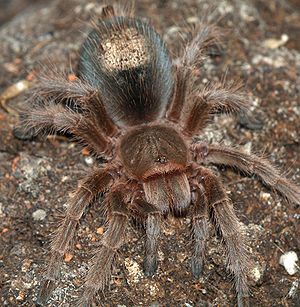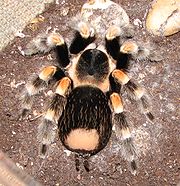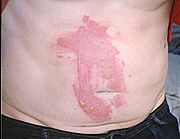
Urticating hair
Encyclopedia

Tarantula
Tarantulas comprise a group of often hairy and often very large arachnids belonging to the family Theraphosidae, of which approximately 900 species have been identified. Some members of the same Suborder may also be called "tarantulas" in the common parlance. This article will restrict itself to...
s, and various lepidopteran caterpillars. Urtica is Latin for "nettle
Nettle
Nettles constitute between 24 and 39 species of flowering plants of the genus Urtica in the family Urticaceae, with a cosmopolitan though mainly temperate distribution. They are mostly herbaceous perennial plants, but some are annual and a few are shrubby...
", and hairs that urticate are characteristic of this type of plant, and many other plants in several families. This term also refers to certain types of barbed hair
Hair
Hair is a filamentous biomaterial, that grows from follicles found in the dermis. Found exclusively in mammals, hair is one of the defining characteristics of the mammalian class....
s that cover the dorsal and posterior surface of a tarantula's or caterpillar's abdomen. Many tarantula species will frequently kick hairs off their abdomens, directing them toward potential attackers. These hairs can embed themselves in the other animal's skin or eyes, thus inducing physical irritation.
Urticating hairs in plants
The most common form of urticating hairs in plants are typified by nettles, which possess sharp-pointed hollow hairs seated on a gland which secretes an acrid fluid. The points of these hairs usually break off in the wound, and the acrid fluid is pressed into it. Various plants unrelated to nettles possess similar defensive hairs, and the common names often reflect this (e.g., "spurge nettleSpurge nettle
Spurge nettle , also known as Tread-softly and Finger Rot, is a perennial herb covered with stinging hairs, native to southeastern North America. A member of the family Euphorbiaceae , it is not a true nettle...
").
Urticating hairs in Lepidoptera

Lepidoptera
Lepidoptera is a large order of insects that includes moths and butterflies . It is one of the most widespread and widely recognizable insect orders in the world, encompassing moths and the three superfamilies of butterflies, skipper butterflies, and moth-butterflies...
n families: the Arctiidae
Arctiidae
Arctiidae is a large and diverse family of moths with around 11,000 species found all over the world, including 6,000 neotropical species. This family includes the groups commonly known as tiger moths , which usually have bright colours, footmen , lichen moths and wasp moths...
(tiger moths), Anthelidae
Anthelidae
Anthelidae is a family of Australian lappet moths in the Lepidoptera order. It was previously included in the Lasiocampoidea superfamily, but a recent study resulted in reincluding the family in the superfamily Bombycoidea.-Diversity:...
(lappet moths), Bombycidae
Bombycidae
Bombycidae is a family of moths. The best-known species is Bombyx mori or silkworm, native to northern China and domesticated for millennia...
, Eupterotidae
Eupterotidae
Eupterotidae is a family of insects in the Lepidoptera order.-Diversity:The family consists of four subfamilies and the unplaced Ganissa group...
(bag shelter moths), Lasiocampidae
Lasiocampidae
The Lasiocampidae family of moths are also known as eggars, snout moths or lappet moths. There are over 2000 species worldwide, and probably not all have been named or studied....
, Limacodidae
Limacodidae
Limacodidae or Euclidae is a family of moths in the superfamily Zygaenoidea or the Cossoidea; the placement is in dispute. They are often called slug moths because their caterpillars bear a distinct resemblance to slugs...
, Lymantriidae
Lymantriidae
Lymantriidae is a family of moths. Many of its component species are referred to as "Tussock moths" of one sort or another. The caterpillar, or larval, stage of these species often has a distinctive appearance of alternating bristles and haired projections...
(tussock moths), Megalopygidae
Megalopygidae
Megalopygidae is the technical name of a group of insect species known generally as crinkled flannel moths, or simply Flannel Moths. They occur in North America and the New World tropics. The larvae are called Puss Caterpillars, and with their long hairs, resemble cotton balls...
, Noctuidae
Noctuidae
The Noctuidae or owlet moths are a family of robustly-built moths that includes more than 35,000 known species out of possibly 100,000 total, in more than 4,200 genera. They constitute the largest family in the Lepidoptera....
, Notodontidae
Notodontidae
Notodontidae is a family of moths with approximately 3,500 known species. Moths of this family are found in all parts of the world, but they are most concentrated in tropical areas, especially in the New World...
(processionary caterpillars), Nymphalidae
Nymphalidae
The Nymphalidae is a family of about 5,000 species of butterflies which are distributed throughout most of the world. These are usually medium sized to large butterflies. Most species have a reduced pair of forelegs and many hold their colourful wings flat when resting. They are also called...
, and Saturniidae
Saturniidae
The Saturniidae, commonly known as saturniids, are among the largest and most spectacular of the moths. They form a family of Lepidoptera, with an estimated 1,300 to 1,500 described species worldwide...
(Matheson 1950, Riley and Johannsen 1938, Roth and Eisner 1962, Wirtz 1984). Some adults may also have urticating scales.
Development
Urticating hairs do not appear at birth but form with each consecutive molt, outwardly presenting themselves around areas of more dark hairs on the upper back part of the abdomen of juveniles, widening from molt to molt, but in elder ages merging with the main tone of abdominal coloration. Urticating hairs do not cover the entire opisthosomaOpisthosoma
The opisthosoma is the posterior part of the body in some arthropods, behind the prosoma . It is a distinctive feature of the subphylum Chelicerata...
and are distinct from abdominal hairs.
Types
There are six different types of urticating hair known in tarantulas (M. Overton, 2002). They are all different in shape and size.- Type I (0.2–0.6 mm)
- Type II (0.5–1.5 mm)
- Type III (0.3–1.2 mm)
- Type IV (0.06–0.2 mm)
- Type V
- Type VI
Each type of urticating hair is believed to target different enemies. Defined targets for some hair types are unknown.
Type II is usually not kicked off by the tarantula, rather delivered by direct contact. However, there is at least one aviculariine species - Avicularia versicolor - which can kick type II urticating hairs off the abdomen, similarly to species from the subfamily Theraphosinae. Tarantulas from the genera Avicularia
Avicularia
Avicularia is a genus of the family Theraphosidae containing various species of tarantulas. The genus is native to tropical South America. Each species in the genus has very distinguishable pink foot pads....
, Pachistopelma and Iridopelma possess Type II hairs. (Toni Hoover, 1997)
Type III urticating hairs are most efficient for defence against vertebrates and invertebrates.
Types III and IV are the most irritating to mammalian predators.
Types particular to species

Type II urticating hairs can be found in the genera Avicularia
Avicularia
Avicularia is a genus of the family Theraphosidae containing various species of tarantulas. The genus is native to tropical South America. Each species in the genus has very distinguishable pink foot pads....
, Iridopelma and Pachistopelma (subfamily Aviculariinae).
Type I and III urticating hairs are representative on Lasiodora and Acanthoscurria, excluding Grammostola
Grammostola
Grammostola is a genus of the tarantula family, Theraphosidae, being native to tropical South America.These spiders are medium to large in size and usually brown in color, with pinkish or orangish-red hairs...
(exhibits types III and IV).
Type III urticating hair is typically found on the species of Theraphosa
Theraphosa
Theraphosa is a genus of tarantula spiders of South America. The two species of the genus are large....
spp., Nhandu spp., Megaphoboema spp., Sericopelma spp., Eupalaestrus spp., Proshapalopus spp., Brachypelma
Brachypelma
Brachypelma is a genus of the family Theraphosidae containing various species of tarantulas.-Characteristics:The species are native to parts of Central America. Habitat destruction and pet-trade collection has led these spiders to be among the few arthropods protected under the international CITES...
spp., Cyrtopholis spp., Iracema spp. and other genera of subfamily Theraphosinae (Rick West, 2002).
Type V urticating hair is typical of the species of genus Ephebopus. They are located on the pedipalps. They are much shorter and lighter in contrast with other types of urticating hair. These are easily thrown by the spider into the air (Marshal and Uetz, 1990).
Type VI urticating hair is found in the genus Hemirrhagus (F. Perez-Miles, 1998).
According to Vellard (1936) and Buecherl (1951), genera with the most urticating hairs are Lasiodora, Grammostola and Acanthoscurria.
Defensive behavior utilizing urticating hairs
New WorldNew World
The New World is one of the names used for the Western Hemisphere, specifically America and sometimes Oceania . The term originated in the late 15th century, when America had been recently discovered by European explorers, expanding the geographical horizon of the people of the European middle...
tarantulas will at the moment of danger, turn toward the attacker and briskly rub their hind legs against the opisthosoma
Opisthosoma
The opisthosoma is the posterior part of the body in some arthropods, behind the prosoma . It is a distinctive feature of the subphylum Chelicerata...
throwing the urticating hairs in the direction of the enemy. The cloud of small hairs will get into the mucous membrane of small mammals and cause edema
Edema
Edema or oedema ; both words from the Greek , oídēma "swelling"), formerly known as dropsy or hydropsy, is an abnormal accumulation of fluid beneath the skin or in one or more cavities of the body that produces swelling...
, which can be fatal. The latest studies suggest these hairs cause both mechanical and chemical harm to the skin and membranes.
Reaction and the degree of irritation to a defensive urticating hair barrage can vary tremendously, based on the species in question. Some, such as those of the Chilean rose hair (Grammastola rosea) and the pinktoe tarantula
Pinktoe Tarantula
The pinktoe tarantula, Avicularia avicularia, is a species of tarantula native to South America, Costa Rica to Brazil, and the southern Caribbean...
(Avicularia avicularia), are fairly mild and innocuous to humans. Others, such as those of the Brazilian giant white knee tarantula (Acanthoscurria geniculata), are moderately irritating. Still others, such as the Goliath Birdeater
Goliath birdeater
The Goliath bird-eater Spider is an arachnid belonging to the tarantula group, Theraphosidae, and is considered to be the second largest spider in the world , and they may be the biggest by mass...
(Theraphosa blondi), are far more severe. These hairs can result in painful rashes, and have been likened to sharp shards of fiberglass.
After a defensive maneuver, an urticating hair lobbing tarantula will have a bald spot on its abdominal region.
Urticating hair as territorial markings
Urticating hair is not just thrown at an enemy as a first line defense, but is also used as an indication of territory. It can be found on and around the burrow entrance and in webbing for protection (for example, some of Theraphosinae subfamily species include these hairs in cocoon silk).Urticating hair can also be found protecting tarantula egg sacs (Avicularia spp. and Theraphosa blondi respectively). This is thought to discourage fly larvae
Fly
True flies are insects of the order Diptera . They possess a pair of wings on the mesothorax and a pair of halteres, derived from the hind wings, on the metathorax...
from consuming their eggs and young.
Human reactions to urticating hair contact

Mucous membrane
The mucous membranes are linings of mostly endodermal origin, covered in epithelium, which are involved in absorption and secretion. They line cavities that are exposed to the external environment and internal organs...
s explains the different reactions of people to urticating hairs (Rick West, 2002).
It seems likely the hairs cause an accumulative reaction in people.
A solution of 2–2.5% hydrocortisone cream applied to the affected area may help relieve the symptoms.
A more serious consequence is urticating hair in the eyes. Ophthalmia nodosa
Ophthalmia nodosa
Ophthalmia nodosa is a cutaneous condition characterized by inflammation of the eye due to lodging of caterpillar hairs in the conjunctiva, cornea, or iris....
, an irritation reaction, can result when the barbed hairs lodge in the cornea. In this case it is necessary to immediately wash the eye thoroughly with copious amounts of cold water and see an ophthalmologist. Handlers are advised to wear eye protection.
External links
- Urticating Caterpillars chapter in United States Environmental Protection Agency and University of FloridaUniversity of FloridaThe University of Florida is an American public land-grant, sea-grant, and space-grant research university located on a campus in Gainesville, Florida. The university traces its historical origins to 1853, and has operated continuously on its present Gainesville campus since September 1906...
/Institute of Food and Agricultural SciencesInstitute of Food and Agricultural SciencesThe University of Florida’s Institute of Food and Agricultural Sciences is a federal-state-county partnership dedicated to developing knowledge in agriculture, human and natural resources, and the life sciences, and enhancing and sustaining the quality of human life by making that information...
National Public Health Pesticide Applicator Training Manual - Summary of Lancet article at Physorg.

